Lexus IS300h 2015 Owner's Manual
Manufacturer: LEXUS, Model Year: 2015, Model line: IS300h, Model: Lexus IS300h 2015Pages: 628, PDF Size: 137.89 MB
Page 471 of 628
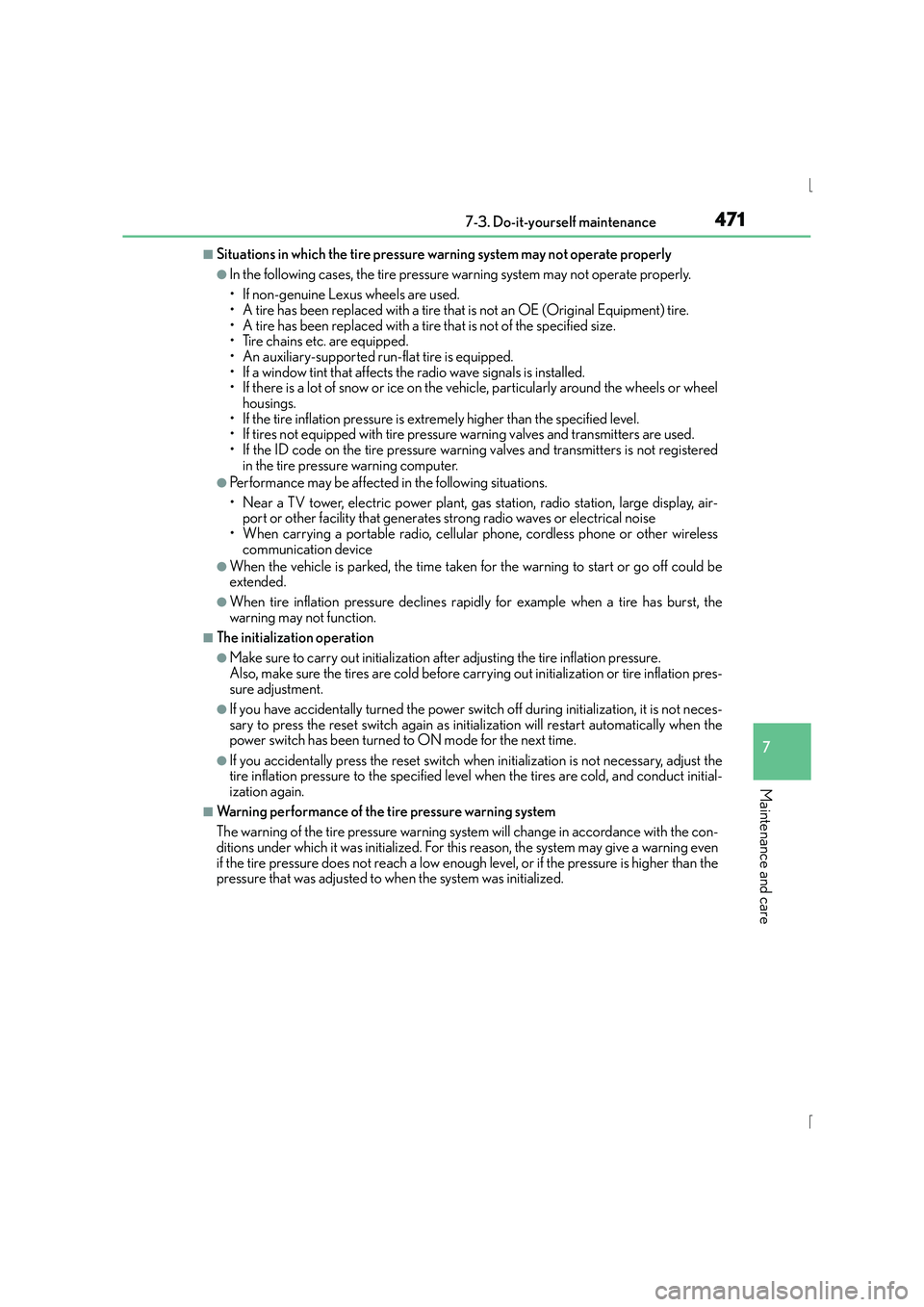
4717-3. Do-it-yourself maintenance
7
Maintenance and care
IS300h_EE(OM53D56E)
Ō¢ĀSituations in which the tire pressure warning system may not operate properly
ŌŚÅIn the following cases, the tire pressure warning system may not operate properly.
ŌĆó If non-genuine Lexus wheels are used.
ŌĆó A tire has been replaced with a tire that is not an OE (Original Equipment) tire.
ŌĆó A tire has been replaced with a tire that is not of the specified size.
ŌĆó Tire chains etc. are equipped.
ŌĆó An auxiliary-supported run-flat tire is equipped.
ŌĆó If a window tint that affects the radio wave signals is installed.
ŌĆó If there is a lot of snow or ice on the vehicle, particularly around the wheels or wheelhousings.
ŌĆó If the tire inflation pressure is extremely higher than the specified level.
ŌĆó If tires not equipped with tire pressure warning valves and transmitters are used.
ŌĆó If the ID code on the tire pressure warning valves and transmitters is not registered in the tire pressure warning computer.
ŌŚÅPerformance may be affected in the following situations.
ŌĆó Near a TV tower, electric power plant, gas station, radio station, large display, air-
port or other facility that generates strong radio waves or electrical noise
ŌĆó When carrying a portable radio, cellular phone, cordless phone or other wireless communication device
ŌŚÅWhen the vehicle is parked, the time taken for the warning to start or go off could be
extended.
ŌŚÅWhen tire inflation pressure declines rapidly for example when a tire has burst, the
warning may not function.
Ō¢ĀThe initialization operation
ŌŚÅMake sure to carry out initialization afte r adjusting the tire inflation pressure.
Also, make sure the tires are cold before carry ing out initialization or tire inflation pres-
sure adjustment.
ŌŚÅIf you have accidentally turned the power switch off during initialization, it is not neces-
sary to press the reset switch again as init ialization will restart automatically when the
power switch has been turned to ON mode for the next time.
ŌŚÅIf you accidentally press the reset switch wh en initialization is not necessary, adjust the
tire inflation pressure to the specified leve l when the tires are cold, and conduct initial-
ization again.
Ō¢ĀWarning performance of the tire pressure warning system
The warning of the tire pressu re warning system will change in accordance with the con-
ditions under which it was initialized. For this reason, the system may give a warning even
if the tire pressure does not reach a low enough level, or if the pressure is higher than the
pressure that was adjusted to when the system was initialized.
Page 472 of 628

4727-3. Do-it-yourself maintenance
IS300h_EE(OM53D56E)
Ō¢ĀWhen initialization of the tire pressure warning system has failed
Initialization can be completed in a few minutes. However, in the following cases, the set-
tings have not been recorded and the syst em will not operate properly. If repeated
attempts to record tire inflation pressure settings are unsuccessful, have the vehicle
inspected by any authorized Lexus dealer or repairer, or another duly qualified and
equipped professional.
ŌŚÅWhen operating the tire pressure warning reset switch, the tire pressure warning light
does not blink 3 times.
ŌŚÅAfter carrying out the initializat ion procedure, the tire pressure warning light blinks for 1
minute then stays on after driving for 20 minutes.
Ō¢ĀRegistering ID codes
The ID codes of the tire pressure warning valve and transmitters for two sets of wheels
can be registered.
It is not necessary to register the ID codes when replacing normal tires with snow tires, if
the ID codes for the wheels of both normal tires and snow tires are registered before-
hand.
For information about changing ID codes, ask any authorized Lexus dealer or repairer,
or another duly qualified and equipped professional.
Page 473 of 628
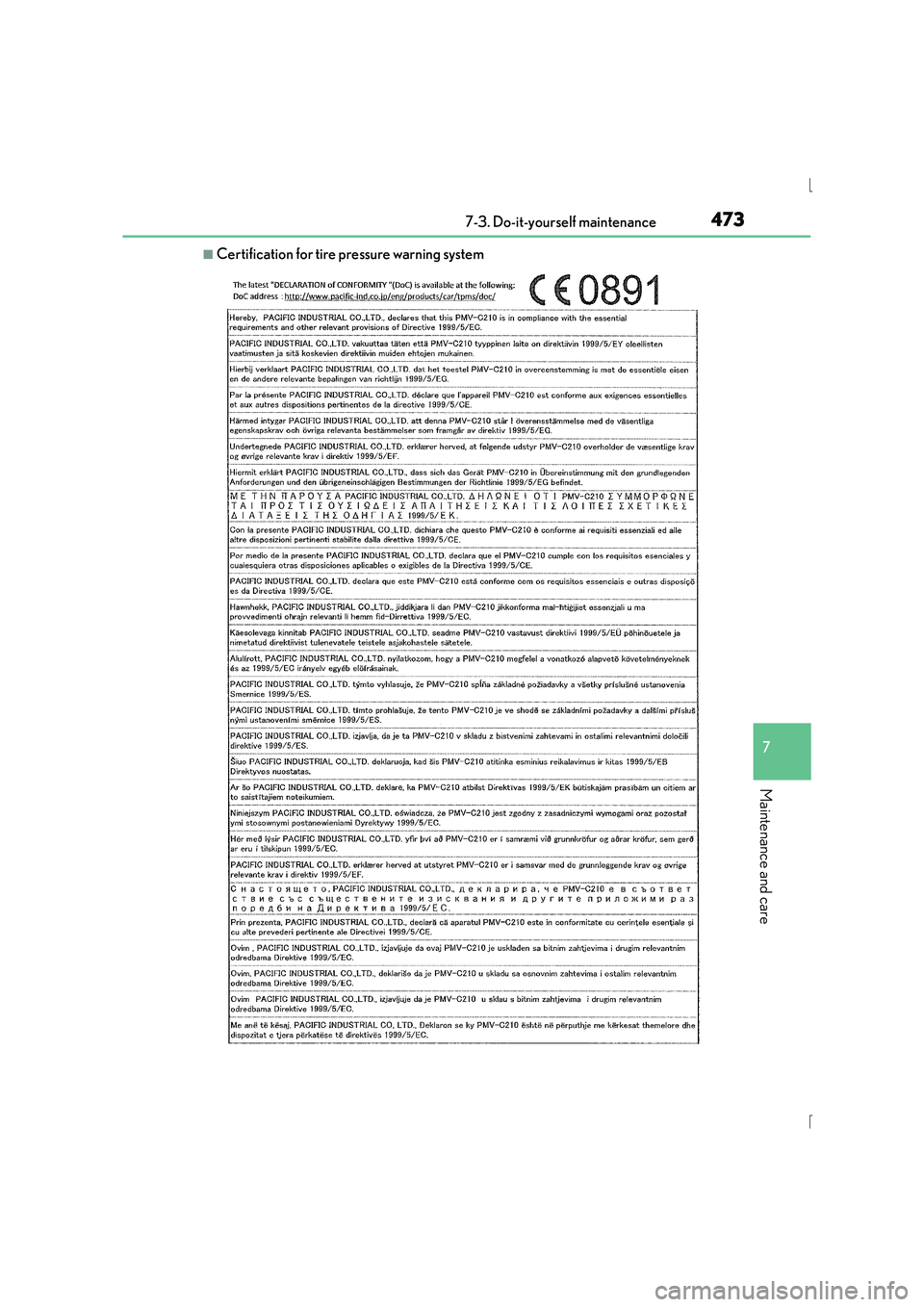
4737-3. Do-it-yourself maintenance
7
Maintenance and care
IS300h_EE(OM53D56E)
Ō¢ĀCertification for tire pressure warning system
Page 474 of 628
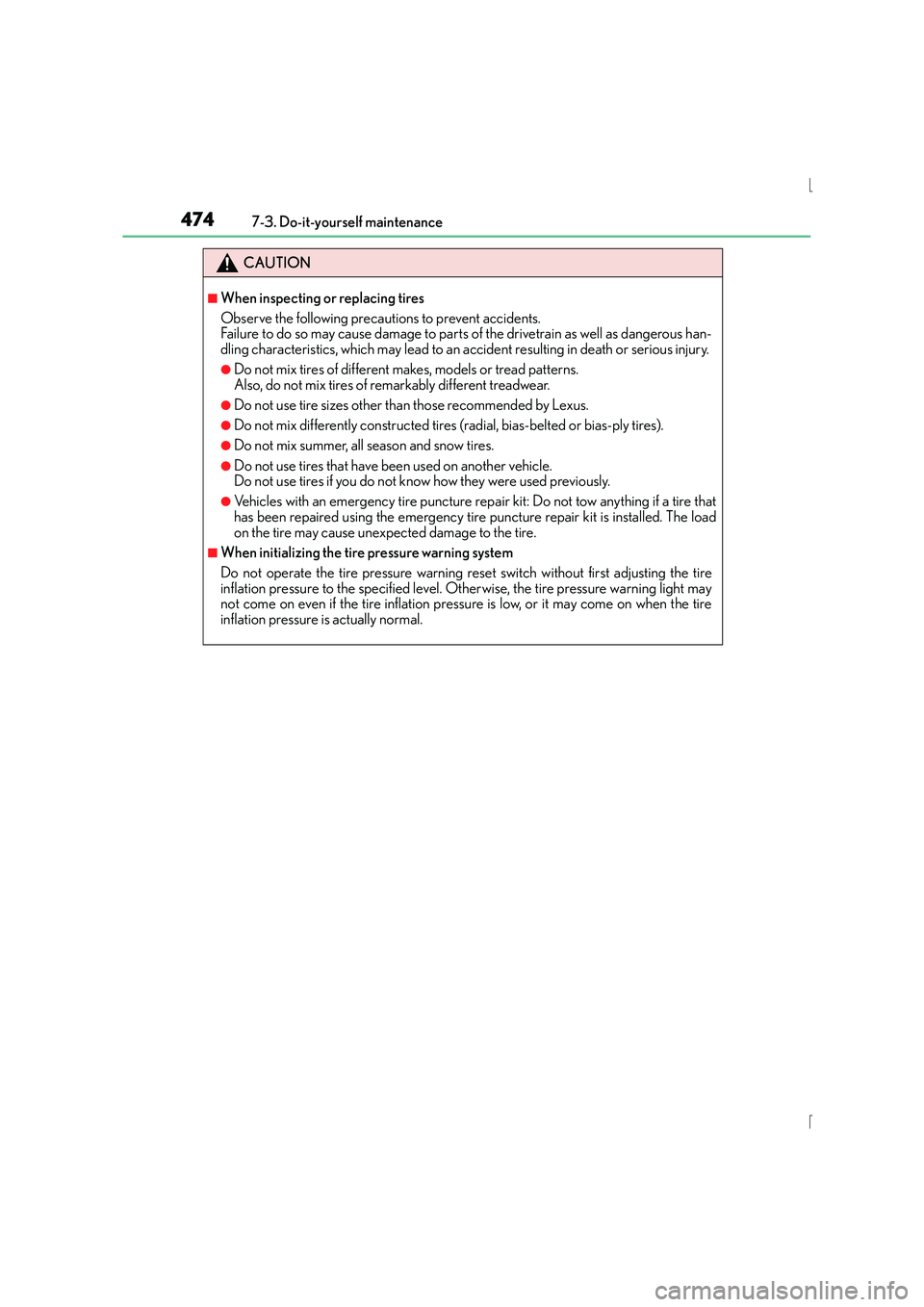
4747-3. Do-it-yourself maintenance
IS300h_EE(OM53D56E)
CAUTION
Ō¢ĀWhen inspecting or replacing tires
Observe the following precautions to prevent accidents.
Failure to do so may cause damage to parts of the drivetrain as well as dangerous han-
dling characteristics, which may lead to an accident resulting in death or serious injury.
ŌŚÅDo not mix tires of different makes, models or tread patterns.
Also, do not mix tires of remarkably different treadwear.
ŌŚÅDo not use tire sizes other than those recommended by Lexus.
ŌŚÅDo not mix differently constructed tires (radial, bias-belted or bias-ply tires).
ŌŚÅDo not mix summer, all season and snow tires.
ŌŚÅDo not use tires that have been used on another vehicle.
Do not use tires if you do not know how they were used previously.
ŌŚÅVehicles with an emergency tire puncture repair kit: Do not tow anything if a tire that
has been repaired using the emergency tire puncture repair kit is installed. The load
on the tire may cause unexpected damage to the tire.
Ō¢ĀWhen initializing the tire pressure warning system
Do not operate the tire pressure warning reset switch without first adjusting the tire
inflation pressure to the specified level. Otherwise, the tire pressure warning light may
not come on even if the tire inflation pressu re is low, or it may come on when the tire
inflation pressure is actually normal.
Page 475 of 628
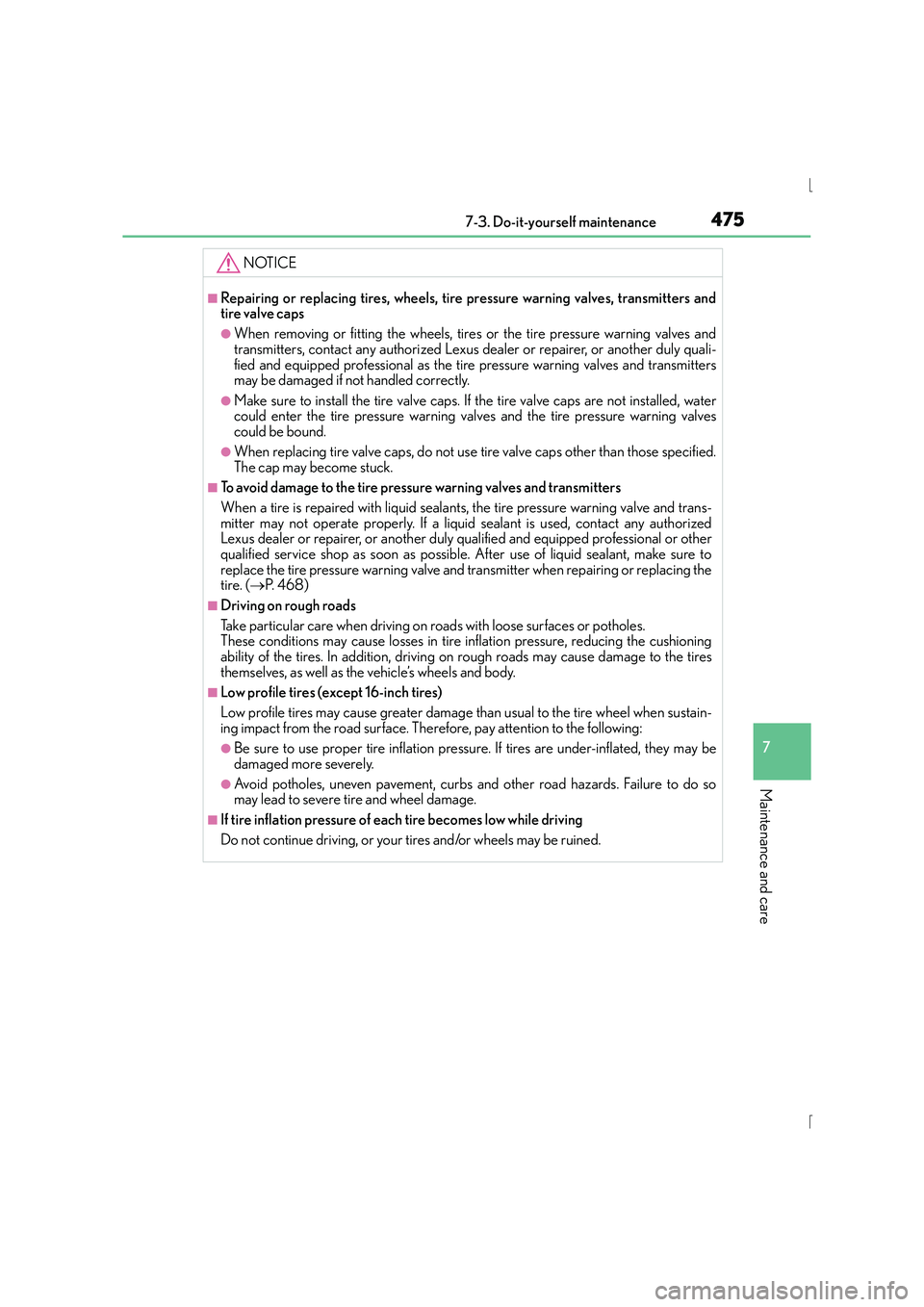
4757-3. Do-it-yourself maintenance
7
Maintenance and care
IS300h_EE(OM53D56E)
NOTICE
Ō¢ĀRepairing or replacing tires, wheels, tire pressure warning valves, transmitters and
tire valve caps
ŌŚÅWhen removing or fitting the wheels, tires or the tire pressure warning valves and
transmitters, contact any authorized Lexus dealer or repairer, or another duly quali-
fied and equipped professional as the tire pressure warning valves and transmitters
may be damaged if not handled correctly.
ŌŚÅMake sure to install the tire valve caps. If the tire valve caps are not installed, water
could enter the tire pressure warning valves and the tire pressure warning valves
could be bound.
ŌŚÅWhen replacing tire valve caps, do not use tire valve caps other than those specified.
The cap may become stuck.
Ō¢ĀTo avoid damage to the tire pressure warning valves and transmitters
When a tire is repaired with liquid sealants , the tire pressure warning valve and trans-
mitter may not operate properly. If a liquid sealant is used, contact any authorized
Lexus dealer or repairer, or another duly qu alified and equipped professional or other
qualified service shop as soon as possible. After use of liquid sealant, make sure to
replace the tire pressure warning valve and transmitter when repairing or replacing the
tire. ( ŌåÆP. 4 6 8 )
Ō¢ĀDriving on rough roads
Take particular care when driving on roads with loose surfaces or potholes.
These conditions may cause losses in tire inflation pressure, reducing the cushioning
ability of the tires. In addition, driving on rough roads may cause damage to the tires
themselves, as well as the vehicleŌĆÖs wheels and body.
Ō¢ĀLow profile tires (except 16-inch tires)
Low profile tires may cause greater damage than usual to the tire wheel when sustain-
ing impact from the road surface. Therefore, pay attention to the following:
ŌŚÅBe sure to use proper tire inflation pressure. If tires are under-inflated, they may be
damaged more severely.
ŌŚÅAvoid potholes, uneven pavement, curbs and other road hazards. Failure to do so
may lead to severe tire and wheel damage.
Ō¢ĀIf tire inflation pressure of each tire becomes low while driving
Do not continue driving, or your tires and/or wheels may be ruined.
Page 476 of 628
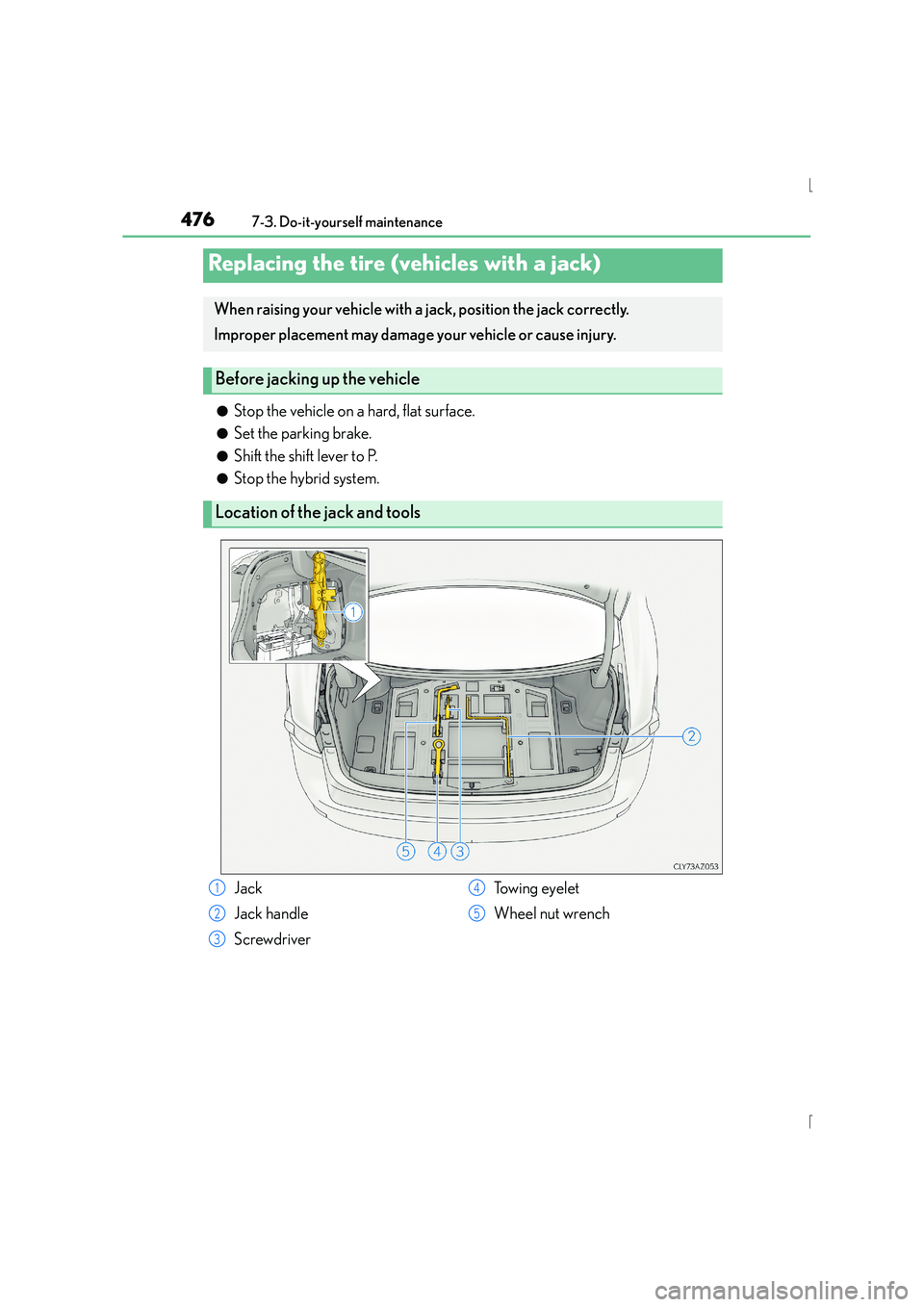
4767-3. Do-it-yourself maintenance
IS300h_EE(OM53D56E)
ŌŚÅStop the vehicle on a hard, flat surface.
ŌŚÅSet the parking brake.
ŌŚÅShift the shift lever to P.
ŌŚÅStop the hybrid system.
Replacing the tire (vehicles with a jack)
When raising your vehicle with a jack, position the jack correctly.
Improper placement may damage your vehicle or cause injury.
Before jacking up the vehicle
Location of the jack and tools
Jack
Jack handle
Screwdriver Towing eyelet
Wheel nut wrench1
2
3
4
5
Page 477 of 628

4777-3. Do-it-yourself maintenance
7
Maintenance and care
IS300h_EE(OM53D56E)
Remove the 12-volt battery cover. (ŌåÆP. 463)
Take out the jack. For tightening
For loosening
If the jack is too tightly installed to be
removed by hand, insert a tool, such
as the screwdriver included with the
vehicle, into the hole of the jack (por-
tion ŌĆ£AŌĆØ) and loosen the jack.
CAUTION
Ō¢ĀUsing the tire jack
Observe the following precautions.
Improper use of the tire jack may cause the vehicle to suddenly fall off the jack, leading
to death or serious injury.
ŌŚÅDo not use the tire jack for any purpose other than replacing tires or installing and
removing tire chains.
ŌŚÅOnly use the tire jack that comes with this vehicle for replacing a tire.
Do not use it on other vehicles, and do not use other tire jacks for replacing tires on
this vehicle.
ŌŚÅPut the jack properly in its jack point.
ŌŚÅDo not put any part of your body under the vehicle while it is supported by the jack.
ŌŚÅDo not start the hybrid system or drive the vehicle while the vehicle is supported by
the jack.
ŌŚÅDo not raise the vehicle while someone is inside.
ŌŚÅWhen raising the vehicle, do not put an object on or under the jack.
ŌŚÅDo not raise the vehicle to a height greater than that required to replace the tire.
ŌŚÅUse a jack stand if it is necessary to get under the vehicle.
ŌŚÅWhen lowering the vehicle, make sure that there is no-one near the vehicle. If there
are people nearby, warn them vocally before lowering.
Taking out the jack
1
2
1
2
Page 478 of 628
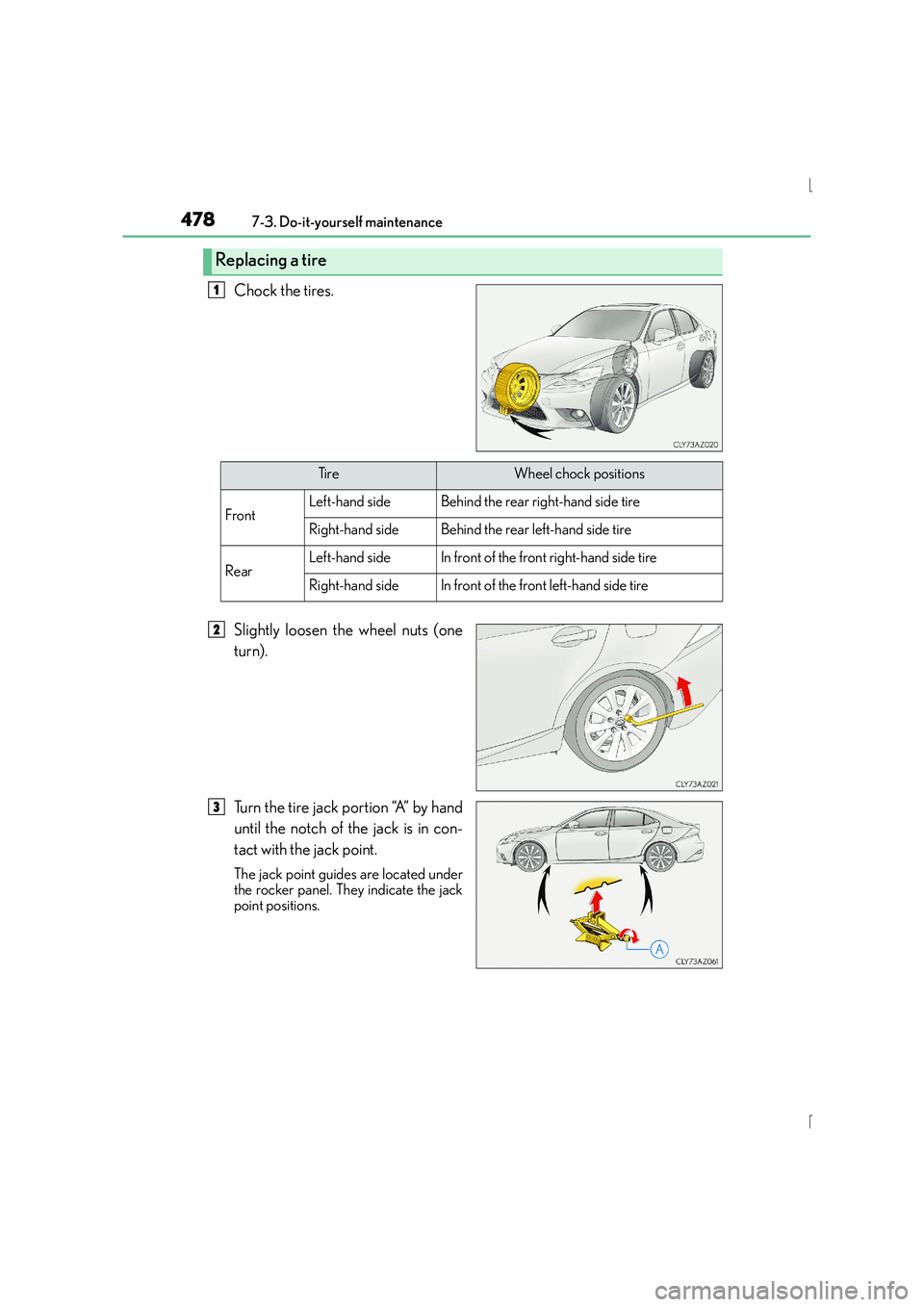
4787-3. Do-it-yourself maintenance
IS300h_EE(OM53D56E)
Chock the tires.
Slightly loosen the wheel nuts (one
turn).
Turn the tire jack portion ŌĆ£AŌĆØ by hand
until the notch of the jack is in con-
tact with the jack point.
The jack point guides are located under
the rocker panel. They indicate the jack
point positions.
Replacing a tire
1
Ti r eWheel chock positions
FrontLeft-hand sideBehind the rear right-hand side tire
Right-hand sideBehind the rear left-hand side tire
RearLeft-hand sideIn front of the front right-hand side tire
Right-hand sideIn front of the front left-hand side tire
2
3
Page 479 of 628
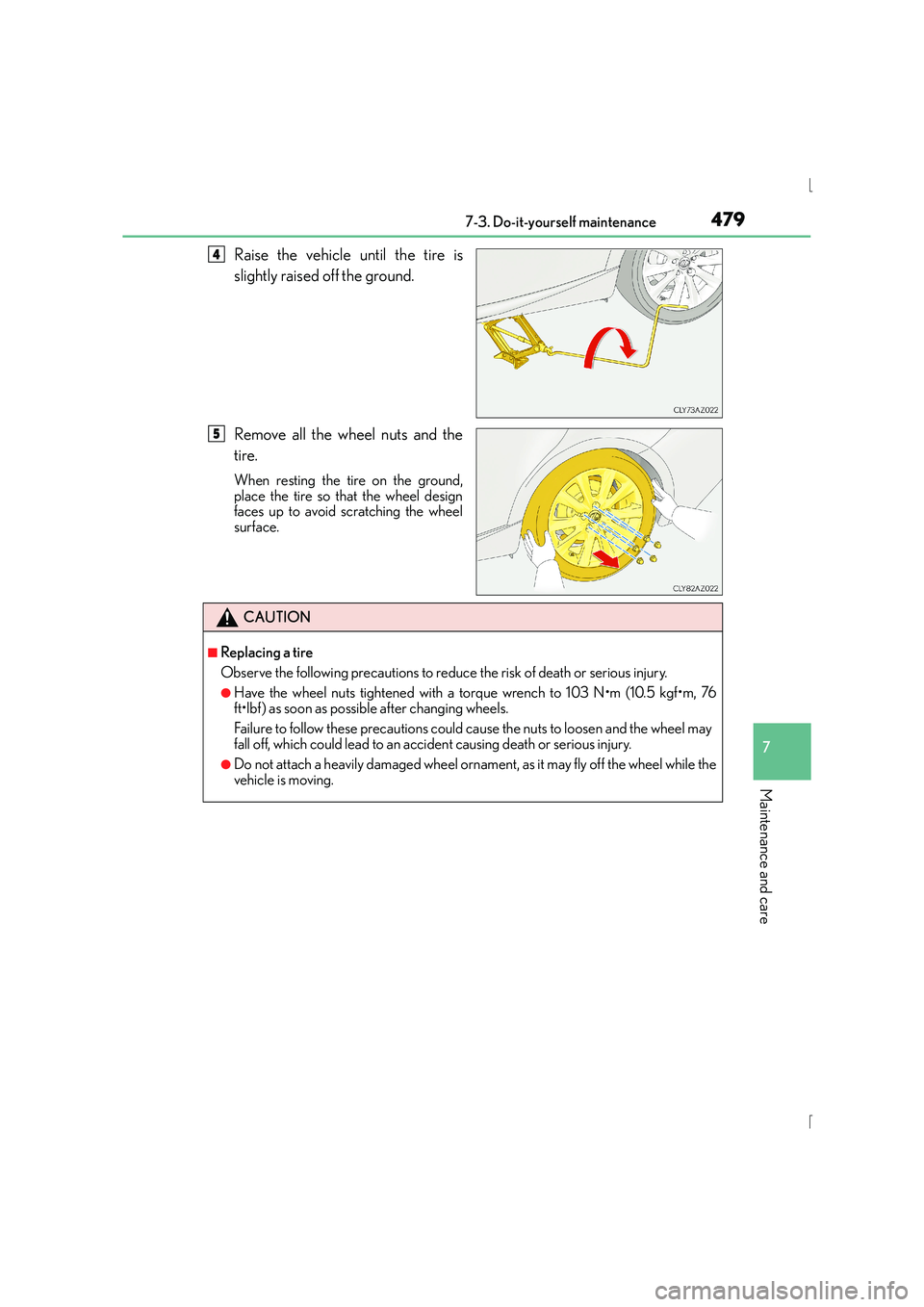
4797-3. Do-it-yourself maintenance
7
Maintenance and care
IS300h_EE(OM53D56E)
Raise the vehicle until the tire is
slightly raised off the ground.
Remove all the wheel nuts and the
tire.
When resting the tire on the ground,
place the tire so that the wheel design
faces up to avoid scratching the wheel
surface.
4
5
CAUTION
Ō¢ĀReplacing a tire
Observe the following precautions to reduce the risk of death or serious injury.
ŌŚÅHave the wheel nuts tightened with a torque wrench to 103 NŌĆóm (10.5 kgfŌĆóm, 76
ftŌĆólbf) as soon as possible after changing wheels.
Failure to follow these precautions could cause the nuts to loosen and the wheel may
fall off, which could lead to an accident causing death or serious injury.
ŌŚÅDo not attach a heavily damaged wheel orname nt, as it may fly off the wheel while the
vehicle is moving.
Page 480 of 628
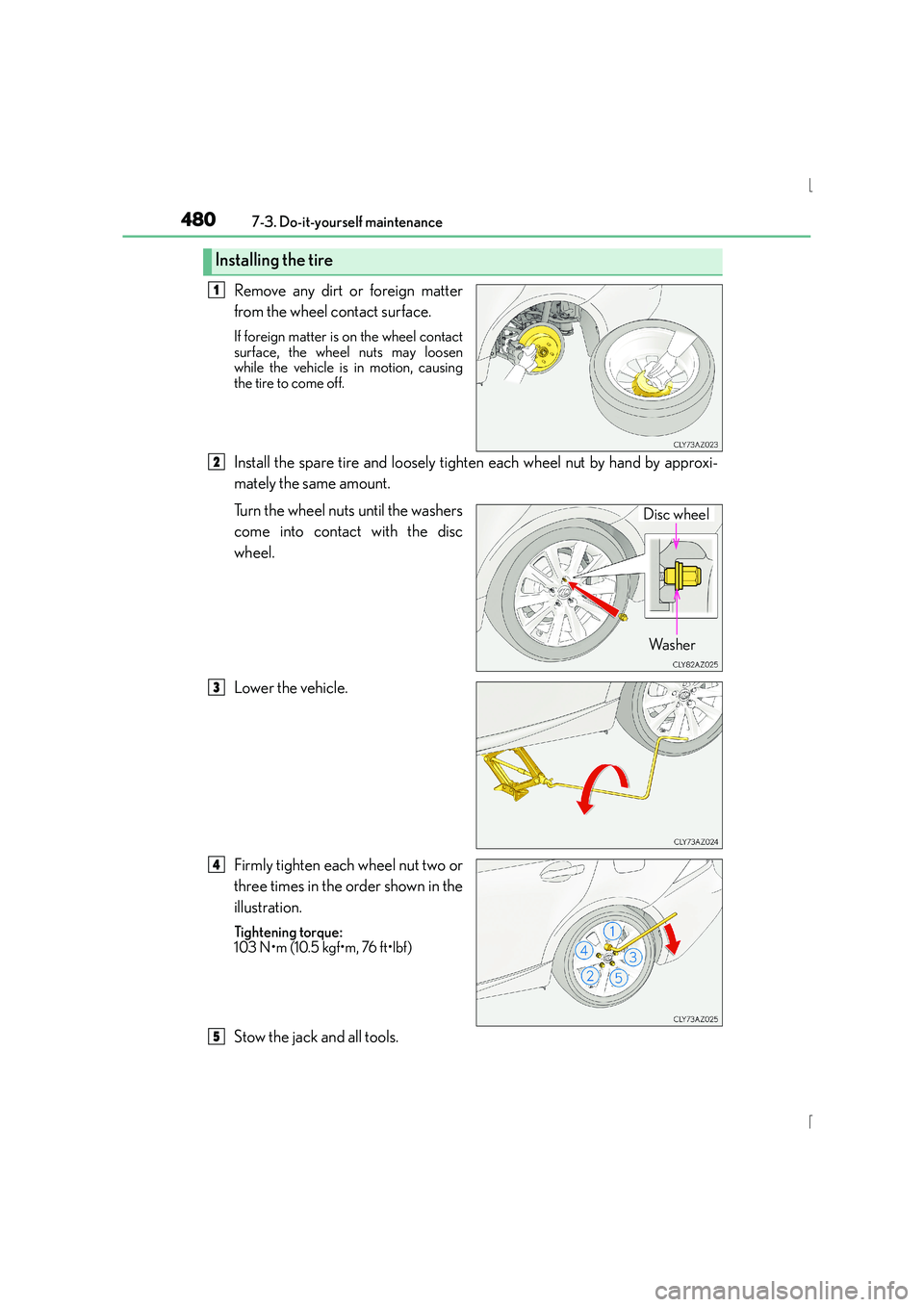
4807-3. Do-it-yourself maintenance
IS300h_EE(OM53D56E)
Remove any dirt or foreign matter
from the wheel contact surface.
If foreign matter is on the wheel contact
surface, the wheel nuts may loosen
while the vehicle is in motion, causing
the tire to come off.
Install the spare tire and loosely tighten each wheel nut by hand by approxi-
mately the same amount.
Turn the wheel nuts until the washers
come into contact with the disc
wheel.
Lower the vehicle.
Firmly tighten each wheel nut two or
three times in the order shown in the
illustration.
Tightening torque:
103 NŌĆóm (10.5 kgfŌĆóm, 76 ftŌĆólbf)
Stow the jack and all tools.
Installing the tire
1
2
Disc wheel
Wa s h e r
3
4
5